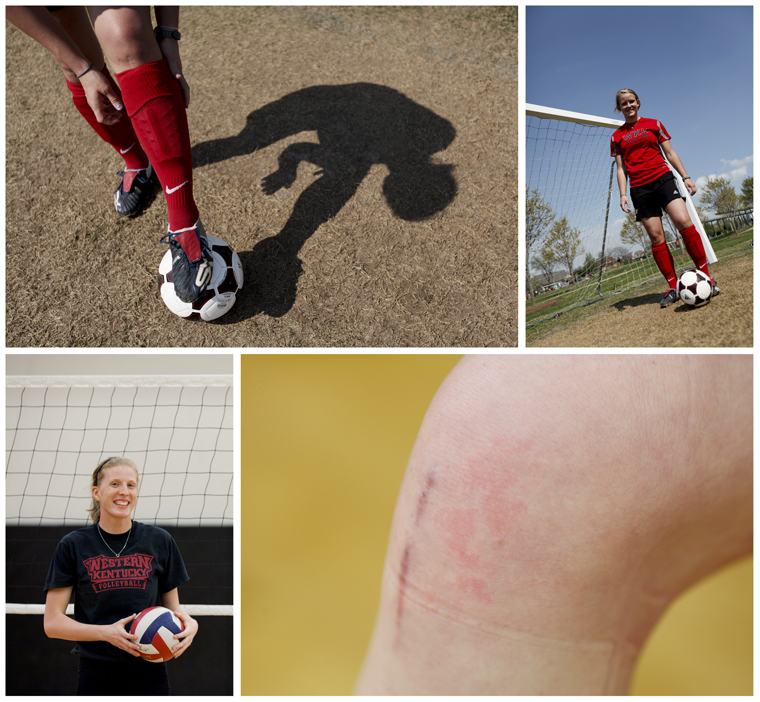Torn Dreams: Three WKU athletes make long recovery from ACL injuries
April 12, 2011
Junior volleyball player Tiffany Elmore said she got goosebumps on her arm just recalling how it happened.
The middle hitter went up for a ball and hit it over the net during the first round of the 2010 NCAA tournament, just like she had done countless times since she started playing in the seventh grade.
But this time, when the North Vernon, Ind., native came down from the spike, she felt a pain that she had never experienced before.
“It was just like any other hit,” Elmore said. “I was going up to hit, and when I landed, it felt like my legs just went. I felt my kneecap pop in and out.
“Right then, I felt pain instantly. All of a sudden, I just dropped. I knew it wasn’t right. I knew that kind of pain was not usual. I had pain before, but this was just the kind that hadn’t happened before.”
Days later, Elmore was diagnosed with a torn anterior cruciate ligament, or ACL, which she said is an “athlete’s worst fear.”
It’s an injury that affects multiple WKU athletes, like Elmore, who is in her third month of rehabilitation from surgery to repair the ligament.
Cindy Hudson, a physical therapist at WKU and wife of head volleyball coach Travis Hudson, said a torn ACL guarantees a minimum six-month recovery time, with some athletes taking up to a year to return or not being able to return at all.
Cindy Hudson works with athletes during this recovery process.
“There are a high percentage of people who did it with non-contact,” she said. “Meaning they aren’t getting tackled on the football field. They don’t come down on somebody. It just happens.”
ACL tears happen more commonly in females than in males. Cindy Hudson said research shows it could be related to the sex’s wider hips or that many are on their menstrual cycles when the injury happens.
Some sports also post higher numbers of the injury than others, like soccer.
“It is a combination with soccer,” Cindy Hudson said. “Contact and females. In football, you tend to see more ACLs due to contact. But if you look at basketball, it tends to be no one around them when it happened.”
WKU soccer player Maggie Wilder said she knows all about contact injuries. She broke her leg colliding with another player in May 2007 and then tore her ACL going in for a tackle in June 2008.
Wilder, who is now a senior, took 10 months to be cleared to play again. During that time, she attended two-hour therapy sessions five days a week and saw little progress.
“I knew I would come back, but I was afraid it was going to be different. And it was,” Wilder said. “I lost a whole bunch of my speed, and it was rougher. It just wasn’t the same, but I do get to still play.”
Her story is similar to sophomore football player Courtney Dalcourt, who tore his ACL not just once but twice and still hasn’t played a live game for WKU.
Dalcourt first blew out the knee in fall camp two years ago, missed the entire 2009 season and returned in the spring of 2010 just to have the injury happen again.
As he prepares for this season, Dalcourt said the knee still “has its days” where it bothers him.
“Rehab, with ACL injuries, it doesn’t stop,” he said. “It never stops. There are always areas you can get better. I’m probably a year out from my last surgery, and I’m still not there yet, but I’m working on it.”
Cindy Hudson said an athlete gaining confidence in his or her play after an injury is just another part of the rehab process.
During the 16-to-24 week stage of rehab, she said she will have athletes perform exercises similar to how they injured the knee.
“It is not only muscular memory, but it is also a confidence builder that gets them past, ‘This is how I tore it, I don’t want to do it again,’” she said.
Both Wilder and Dalcourt echoed the thought that if you play timid, you are more likely to get hurt again.
“I think that’s probably why I tore mine the second time,” Dalcourt said. “Not having confidence in it and coming back a bit too early. It is just a mental game. Once you get out there and get your first hit on it — get that first good cut on it — you’re fine.”
Cindy Hudson said she didn’t believe a torn ACL meant the athlete would never be the same again — it would just be “challenging” for him or her to do so.
“There is a constant process to keep them at the level where they can play Division I athletics,” she said. “It is a time commitment to them. It is not just, ‘I got my six months rehab in, I’m done.’ They are going to be in the training room for the rest of their careers.”
Cindy Hudson’s husband, Travis, has seen the injury occur more than once to athletes during his 16 years as a head volleyball coach.
Although athletes may lose something physically, they typically return mentally stronger, he said.
And while the goosebumps haven’t gone away for Elmore yet, Travis Hudson said he expects a strong return from her.
“You never want to see kids go through it,” Travis Hudson said. “You always love having them in the gym. There are many, many times throughout my career where I’ve had a kid who had to sit and watch, and they came back a better player.
“They sit there, and they see things that you just don’t see when you are out on the court. Anything that Tiffany would lose physically, she will gain mentally. I anticipate her having a fantastic senior year.”













